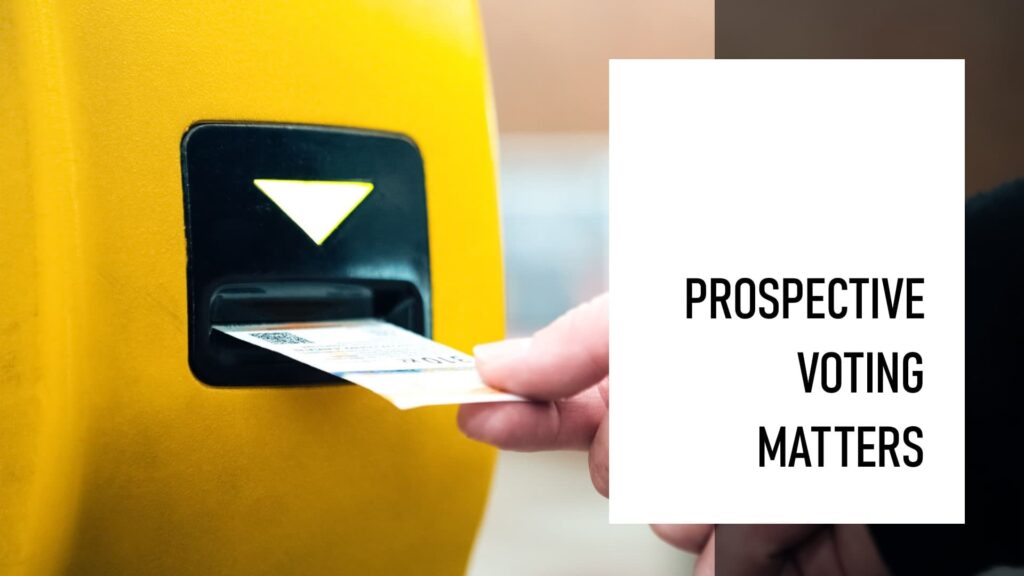When it comes to elections, voters often face a complex decision-making process that requires them to weigh numerous factors. One of the key concepts that guide voters is “prospective voting.” Unlike retrospective voting, where people make decisions based on a candidate’s past actions, prospective voting involves looking toward the future and assessing how candidates’ proposed policies will impact voters’ lives. In this blog post, we’ll dive into what prospective voting is, why it matters, and how it influences elections.
What Is Prospective Voting?
Prospective voting refers to the idea of casting a ballot based on what a voter believes will happen in the future if a particular candidate or party wins. Instead of focusing solely on a politician’s past achievements or failures, prospective voters consider their campaign promises, vision, and the potential outcomes of the policies they are proposing. Essentially, it’s about choosing a candidate whose future plans align with what the voter wants to see happen in the country, state, or local community.
How Prospective Voting Differs from Retrospective Voting
To better understand prospective voting, it helps to compare it to retrospective voting. Retrospective voting is backward-looking; it involves evaluating a candidate or party’s past performance. For example, a voter might support an incumbent candidate because they feel the candidate has delivered good economic results during their previous term. On the other hand, prospective voting is forward-looking. It emphasizes potential future policies over historical performance.
Why Prospective Voting Matters
- Shaping Policy Agendas: Prospective voting puts pressure on candidates to clearly outline their plans and positions on key issues. Voters who engage in prospective voting are more likely to ask hard questions about what the candidate will do to address important concerns, from healthcare and education to climate change and national security. This helps shape the policy discussions leading up to an election.
- Empowering Voters: It allows voters to take control of the future they want to see. When people vote prospectively, they’re not just reacting to the past; they are actively participating in creating the kind of future they want for themselves and their communities.
- Encouraging Accountability: By focusing on future promises, prospective voters can hold politicians accountable. If a candidate wins based on a particular platform but then fails to deliver on those promises, voters can revisit those issues in future elections.
- Increasing Political Engagement: Prospective voting can increase voter engagement. It encourages voters to stay informed on policy issues and motivates them to participate in the political process, as their choices directly impact the direction of future policies.
Examples of Prospective Voting in Action
Consider the issue of climate change, which has become a major focus in many elections. Voters who prioritize environmental issues may choose candidates who promise to implement renewable energy policies and reduce carbon emissions. These voters aren’t as concerned about what the candidate has done in the past regarding the environment but are more focused on what they plan to do in the future. The same logic applies to issues like healthcare reform, tax policy, and education, where voters are often looking for candidates who will enact change that benefits them down the road.
The Challenges of Prospective Voting
While prospective voting can be powerful, it does come with challenges. One of the biggest difficulties is that voters have to rely on promises that may or may not be kept. Political campaigns are often filled with lofty promises that may prove difficult or impossible to fulfill once the candidate is in office. Additionally, voters may have difficulty predicting the full impact of certain policies, particularly when issues are complex or involve long-term outcomes.
Moreover, politicians are sometimes intentionally vague about their future plans, which can make it challenging for prospective voters to make informed decisions. Despite these obstacles, prospective voting remains an essential aspect of democratic elections.
How to Be a Better Prospective Voter
To effectively engage in prospective voting, it’s important to stay informed. Here are a few tips:
- Research Candidate Platforms: Pay close attention to the policy positions and platforms of each candidate. What are their plans for the future, and how do these plans align with your values and priorities?
- Evaluate Feasibility: Think critically about the feasibility of candidates’ promises. Are their goals realistic given the political landscape? Have they provided specific details on how they plan to implement their policies?
- Stay Updated: Follow the news and updates on political issues that matter to you. This ensures that you are voting with a full understanding of how the political landscape may shift in the future.
- Consider the Broader Impact: Remember that the policies proposed by a candidate will have ripple effects. Consider not only how the policies will impact you personally but also how they might affect your community, the country, and even the world.
Conclusion
Prospective voting is a vital part of a healthy democracy, allowing voters to look toward the future and vote for candidates whose policies will shape the world in the years to come. By thinking critically about what candidates are proposing and how those policies align with your vision for the future, you can make an informed decision that helps build a better tomorrow. Whether you’re passionate about healthcare, education, climate change, or economic reform, prospective voting gives you a chance to vote for the future you want to see.



